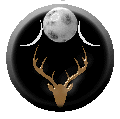|
|
|
SYLVAN

WICCA /SHAMANISM
LESSON 7
Lesson 7: Altars
So how do we begin to apply these concepts that we learned in Lesson Six?
How do we
move from using correspondences as a mental exercise, to having them be a
part of our
magick and our practice?One of the first applications we can use is the creation of an altar.
Think back to the
exercise "Lesson Four: Symbolism." In it, we took physical objects that
symbolized
what we are seeking on this path and displayed them in a specific
location. What you
did was create a very simple altar -- you pulled concepts from your
subconscious,
associated each with one of the items you chose to display, and placed
them in a
specific location. Each time you stopped and considered these items, you
considered
the energy behind them. Your subconscious instinctively built a bridge
between the
object and the corresponding energy, the meaning that the object holds
for you.
When we choose to set up an altar for a specific purpose, we proceed in
much the same
way. We begin by choosing items that have a specific significance to us,
that represent
a certain element or a certain type of energy. And the altars we set up
can differ greatly.
I've been known to use three different altars in my practice from time to
time.
The first is what I refer to as a "path altar." It's very similar to the
concept we
established in the exercise "Symbolism." What it does is create an
ever-changing
snapshot of our spiritual journey. Each item represents either a step
we've made, or a
step we're hoping to take. The purpose behind this is to continually
reaffirm what we
are seeking on our path each time we pass by this altar, as well as
encouraging us by
reminding us of the steps we have already taken.The second type of altar I use is a simple altar used in indoor ritual.
Not only does it
hold the tools and physical elements that I have chosen to use in the
rite, but because
each item symbolizes a specific type of energy and the items are arranged
ritually, the
altar itself heightens the energy needed for the rite and aids in the
focusing on the
ceremony ahead.The third type of altar is one that I use while working in the
wilderness. It's very similar
to the one I use for indoor ritual, but not nearly as elaborate. The
items it holds are all
objects that I've packed in with me or collected once I reach my
destination, so it's
usually a collection of items that I feel a particularly strong
connection to or that I feel
were integral to the rite.Exercise Six: Altars
What I would like you to do is to create an altar a little more
consciously
assembled than the altar you created in "Symbolism." Using the
correspondences that you developed in the last exercise, "The
Symbolism of Energy," select items that meet your established
requirements as corresponding to a specific energy and place them in
a
ritual manner. If you're feeling especially comfortable with the
exercise,
consider the directions associated with each item -- Elemental or
masculine and feminine -- and use that criteria to place the items
on your
altar.With each item, hold it for a moment, visualizing the energy that
you are
associating with it. For instance, you may choose a stone to
represent
Earth or a postcard of the sea to represent Water. As you hold each
item, picture the images that remind you of the specific element or
type
of energy. When you feel a connection to it, place it on the altar,
stating
why you are putting it in its place. For instance, with the stone, I
might
say, "Stone, you represent the earth and I place you in the North."
When you have completed this exercise, record your results, the
placement of items, the visualization of each, and the reasons why
you
placed them where you did. Leave the altar up for as long as you
feel
comfortable doing so. Each time you pass by it, think of the
symbolism
of each item. If you feel that something needs to be moved, do so,
and
record the reasons in your notes.The First Cycle course is written by Graelan Wintertide
and is © 1999 All Rights Reserved